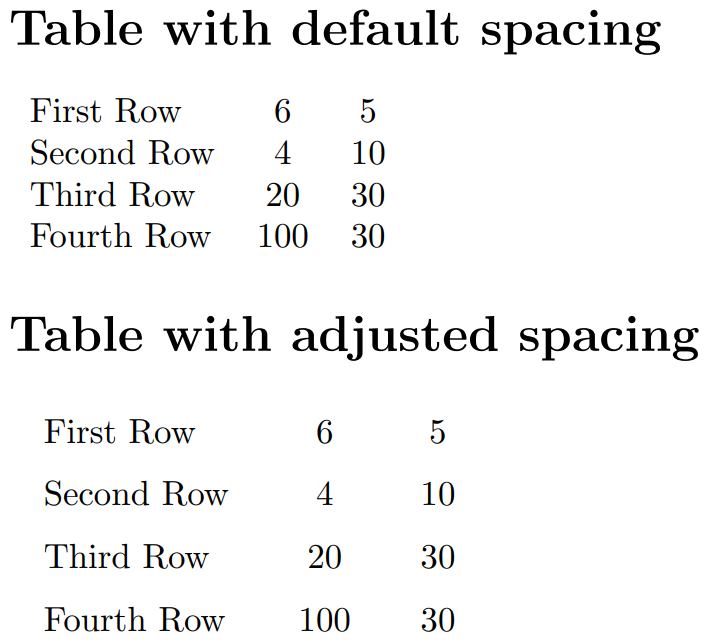How do I change column or row separation in LaTeX tables?
One option is to use the commands \setlength and \arraystretch to change the horizontal spacing (column separation) and the vertical spacing (row separation) respectively; for example:
\setlength{\tabcolsep}{20pt}
\renewcommand{\arraystretch}{1.5}
The following example, which can be opened directly in Overleaf, demonstrates the use of \setlength and \arraystretch spacings.
\documentclass{article}
\begin{document}
\section*{Table with default spacing}
% A table with default row and column spacing
\begin{tabular}{ l c c }
First Row & 6 & 5 \\
Second Row & 4 & 10\\
Third Row & 20 & 30\\
Fourth Row & 100 & 30\\
\end{tabular}
\section*{Table with adjusted spacing}
% A table with adjusted row and column spacing.
% \setlength sets the horizontal (column) spacing
% \arraystretch sets the vertical (row) spacing
\begingroup
\setlength{\tabcolsep}{10pt} % Default value: 6pt
\renewcommand{\arraystretch}{1.5} % Default value: 1
\begin{tabular}{ l c c }
First Row & 6 & 5 \\
Second Row & 4 & 10\\
Third Row & 20 & 30\\
Fourth Row & 100 & 30\\
\end{tabular}
\endgroup
% The \begingroup ... \endgroup pair ensures values of spacing
% parameters only affect this particular table, and not any
% subsequent ones in the document.
\end{document}
This example produces the following output:

Overleaf guides
- Creating a document in Overleaf
- Uploading a project
- Copying a project
- Creating a project from a template
- Using the Overleaf project menu
- Including images in Overleaf
- Exporting your work from Overleaf
- Working offline in Overleaf
- Using Track Changes in Overleaf
- Using bibliographies in Overleaf
- Sharing your work with others
- Using the History feature
- Debugging Compilation timeout errors
- How-to guides
- Guide to Overleaf’s premium features
LaTeX Basics
- Creating your first LaTeX document
- Choosing a LaTeX Compiler
- Paragraphs and new lines
- Bold, italics and underlining
- Lists
- Errors
Mathematics
- Mathematical expressions
- Subscripts and superscripts
- Brackets and Parentheses
- Matrices
- Fractions and Binomials
- Aligning equations
- Operators
- Spacing in math mode
- Integrals, sums and limits
- Display style in math mode
- List of Greek letters and math symbols
- Mathematical fonts
- Using the Symbol Palette in Overleaf
Figures and tables
- Inserting Images
- Tables
- Positioning Images and Tables
- Lists of Tables and Figures
- Drawing Diagrams Directly in LaTeX
- TikZ package
References and Citations
- Bibliography management with bibtex
- Bibliography management with natbib
- Bibliography management with biblatex
- Bibtex bibliography styles
- Natbib bibliography styles
- Natbib citation styles
- Biblatex bibliography styles
- Biblatex citation styles
Languages
- Multilingual typesetting on Overleaf using polyglossia and fontspec
- Multilingual typesetting on Overleaf using babel and fontspec
- International language support
- Quotations and quotation marks
- Arabic
- Chinese
- French
- German
- Greek
- Italian
- Japanese
- Korean
- Portuguese
- Russian
- Spanish
Document structure
- Sections and chapters
- Table of contents
- Cross referencing sections, equations and floats
- Indices
- Glossaries
- Nomenclatures
- Management in a large project
- Multi-file LaTeX projects
- Hyperlinks
Formatting
- Lengths in LaTeX
- Headers and footers
- Page numbering
- Paragraph formatting
- Line breaks and blank spaces
- Text alignment
- Page size and margins
- Single sided and double sided documents
- Multiple columns
- Counters
- Code listing
- Code Highlighting with minted
- Using colours in LaTeX
- Footnotes
- Margin notes
Fonts
Presentations
Commands
Field specific
- Theorems and proofs
- Chemistry formulae
- Feynman diagrams
- Molecular orbital diagrams
- Chess notation
- Knitting patterns
- CircuiTikz package
- Pgfplots package
- Typesetting exams in LaTeX
- Knitr
- Attribute Value Matrices
Class files
- Understanding packages and class files
- List of packages and class files
- Writing your own package
- Writing your own class